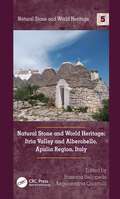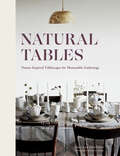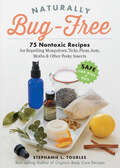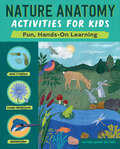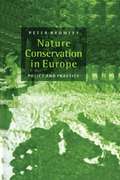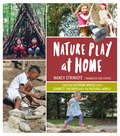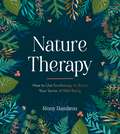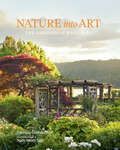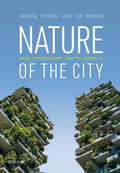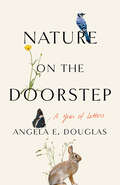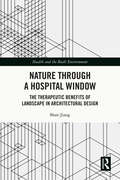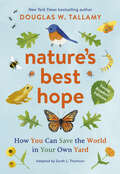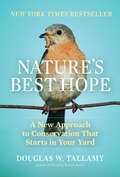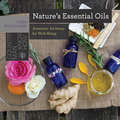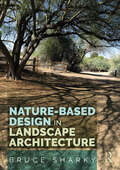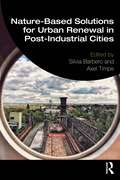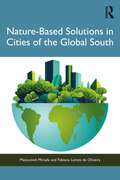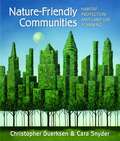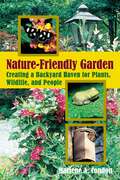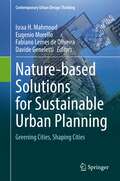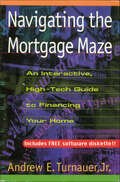- Table View
- List View
Natural Stone and World Heritage: Delhi-Agra, India (Natural Stone and World Heritage)
by Gurmeet Kaur Sakoon N. Singh Anuvinder Ahuja Noor Dasmesh SinghThis book discusses heritage stones which were used in the making of the architectonic heritage of Delhi and Agra, encompassing UNESCO world heritage sites and heritage sites designated as prominent by the Indian government. The most famous monument of the two cities is the ‘Taj Mahal’ of Agra. The book focuses on the geological characteristics of the famous Makrana marble, red sandstone and other sandstone variants of the Vindhyan basin and Delhi quartzite, the most widely used stones in almost all the monuments, as well as on their quarries. The work also aims to sensitise the public to protecting and preserving the architectonic heritage of these two densely populated cities in India as repositories of our past cultures and traditions. Identifying the nature and provenance of stones/rocks used in construction will lead to better restoration for future generations, in light of the deterioration of architectonic heritage through various natural weathering agencies and anthropogenic activities. The book will serve as a useful source book to economic geologists, geologists, archaeologists, architects, historians and stone industry operators specifically and to academic and non-academic communities, travellers and tourism industry operators in general. The book will benefit students, researchers, and rock enthusiasts spanning all age groups and academic levels.
Natural Stone and World Heritage: Itria Valley and Alberobello, Apulia Region, Italy (ISSN)
by Rossana Bellopede Angelamaria QuartulliApulian limestones constitute the historic building constructions of the Puglia region (in the south of Italy) named trulli (representing an outstanding universal value for UNESCO), but also other stone buildings of the well-known Itria Valley. Trulli are drywall (mortarless) constructions made of roughly worked limestone blocks collected from neighbouring fields. The limestone for trulli is quarried from different Apulian localities and, together with another local lithotype, represents the stone heritage of the Itria Valley.This book begins with an introduction to the region of southern Italy where trulli and other typical stone architecture can be found. The Itria Valley with its towns and landscape and the town of Alberobello are described from an architectural point of view. The second section describes the different examples of building constructions in local stone of the Itria Valley, focusing on ancient and contemporary quarries. In this part petrographic and physical mechanical characteristics of the main kind of limestones are reported and discussed. The third part focuses on the main examples of stone architecture of Itria Valley, distinguishing the historical rural buildings from the other historical civil ones. In this section particular attention is given to best practices of evaluation action, protection rules and restoration methods for stone heritage in Itria Valley and Alberobello.This book serves as a useful source of information to geologists, archaeologists, architects, historians and stone industry operators specifically, and to academic and non-academic communities, travellers, and tourism industry operators in general. The book will also be of interest to students, researchers, and rock enthusiasts spanning all age groups and academic levels.
Natural Stone and World Heritage: The Castles and Town Walls of King Edward in Gwynedd (Natural Stone and World Heritage)
by Ruth SiddallThis book is about the stone used to build the castles of Edward I in North West Wales. It provides a description of the available geological resources and the building materials used in the construction of Caernarfon, Conwy, Harlech and Beaumaris Castles. It takes a broad view of this subject, placing the stone used in the castles in the context of both earlier and later buildings across the region of study, from the Neolithic up until the present day. The book will serve as a useful source book for geologists, archaeologists, architects, representatives of the natural stone industry, historians and cultural heritage management professionals specifically and for academic and non-academic communities, travellers and tourism industry operators in general.
Natural Tables: Nature-Inspired Tablescapes for Memorable Gatherings
by Shellie PomeroyLearn to create dazzling tablescapes inspired by nature's beauty with this essential guide to styling stunning tablescapes for any occasion.Discover endless inspiration for stunning table settings. Brimming with inspired table spreads and simple-to-follow tips for incorporating crowd-pleasing recipes and lovely details into every presentation, this gorgeous coffee table book makes it easy to host warm, memorable gatherings—whether you're putting together a cozy brunch, a themed cocktail hour, or a festive holiday party.Photographs of exquisite table settings are paired with helpful styling tips—including how to pick your theme and color palette, select the right tableware, and incorporate nature's bounty—plus simple-to-follow food and drink recipes that guarantee the spreads taste as good as they look.Readers will discover a botanical-themed cocktail cart, an ethereal ocean-inspired setting, a harvest table celebrating autumnal colors, and so much more.EXPERT AUTHOR: Shellie Pomeroy is a celebrated designer and textile artist. Her work has been covered in Martha Stewart Wedding, Vogue, The Knot, and Style Me Pretty, among others. She shares all her secrets to creating showstopping displays using tableware, flowers, candles, fabrics, and more.GIFT WORTHY: With cloth accents and brimming with hundreds of inspired photographs, this book makes a beautiful statement on any coffee table or bookshelf, and a lovely gift for new homeowners, newlyweds, nature lovers, and design enthusiasts.Perfect for:• People who love Joanna Gaines's Magnolia brand or Magnolia Table book• Fans of Platters And Boards, Tables And Spreads, and A Year In Flowers
Naturally Bug-Free: 75 Nontoxic Recipes for Repelling Mosquitoes, Ticks, Fleas, Ants, Moths & Other Pesky Insects
by Stephanie L. TourlesProtect yourself, your children, your pets, and your home from bugs — without using harsh or toxic chemicals! Herbalist Stephanie Tourles offers 75 simple recipes for safe, effective bug repellents you can make at home from all-natural ingredients. For protection from mosquitos, ticks, and other biting insects, there are sprays, balms, body oils, and tinctures, with scents ranging from eucalyptus to floral, lemon, vanilla, and woodsy spice. There are also recipes for pets, such as herbal shampoo, bedding formulas, and flea-and-tick collars and powders. And Tourles includes repellents for the home, such as sachets that repel moths, carpet powders that repel fleas and ants, and essential oil repellents to keep your pantry pest-free. A detailed ingredient dictionary explains the properties of all the herbs, essential oils, and other key ingredients.
Nature Anatomy Activities for Kids: Fun, Hands-On Learning (Anatomy Activities for Kids)
by Kristine BrownThink like a scientist and search like an explorer with this illustrated nature guide for kids ages 8 to 12Get ready to explore the sky above, the ground below, and all the plants and creatures in between! Made just for kids, this nature anatomy book teaches you about the incredible forces and living things that exist in nature.You'll dig in to tons of different topics—from naming the layers of the atmosphere to learning the parts of a flower—and try out fun activities like creating a mini cloud and raising a tadpole. As you explore the natural world around you, you'll become a real scientist by asking questions, imagining outcomes, testing your ideas, and then writing down what you discover.Nature Anatomy Activities for Kids includes:5 Subjects, 20 lessons—Dive in to different chapters for the earth, the sky, water, plants, and animals. Every chapter includes multiple lessons about the topic, with a new activity and a journal prompt for each.Journal like a scientist—Use your own blank journal to answer prompts and take notes so you can write and draw everything you observe or note any questions you want to find an answer for.Detailed illustrations—Colorful pictures and diagrams make this nature anatomy book fun to use and get kids excited about the anatomy of plants, animals, ecosystems, and landscapes.Get outside and explore with this book of nature anatomy activities that opens up a whole new world of learning.
Nature Conservation in Europe: Policy and Practice
by Peter BromleyThe Rio Summit has pointed to the urgency for the development of an international conservation policy; and the post-Maastricht debates in Europe have highlighted the need for the EU to reassess structural funding in nature conservation, as well as the influences on policy and practice.This book is a 'route map' through the legislative and policy frameworks and explains how conservation works in Europe. It goes through the policies for nature conservation in the European Community and its constituent member states and sets out the mechanisms for delivering this policy.An understanding of the European legislative framework is now vital as its influence on local practice increases. Practitioners in the fields of countryside conservation and general land management will find the book an essential guide to the working of the EU, as well as helping an appreciation of their local role within the wider community objectives. This will, for example allow a better understanding of the grant system which many managers are now using.
Nature Play at Home: Creating Outdoor Spaces that Connect Children with the Natural World
by Nancy Striniste“A magnificent resource for transforming backyards into stimulating environments which enhance children’s creativity, learning, and fun.” —Richard Louv, author of Last Child in the Woods, The Nature Principle, and Vitamin N Access to technology has created a generation of children who are more plugged in than ever before—often with negative consequences. But there is a solution. Unrestricted outdoor play helps reduce stress, improve health, and enhance creativity, learning, and attention span. In Nature Play at Home, Nancy Striniste gives you the tools you need to make outdoor adventures possible in your own backyard. With hundreds of inspiring ideas and illustrated, step-by-step projects, this hardworking book details how to create playspaces that use natural materials—like logs, boulders, sand, water, and plants of all kinds. Projects include hillside slides, seating circles, sand pits, and more.
Nature Therapy: How to Use Ecotherapy to Boost Your Sense of Well-Being
by Rémy DambronNature therapy is the practice of reconnecting with the natural world to refresh your physical and mental well-being. Including tips to help you discover your connection with the outdoors, activity inspiration and a holistic approach to wellness, this book is the ultimate guide to unlocking the transformative power of nature.
Nature Therapy: How to Use Ecotherapy to Boost Your Sense of Well-Being
by Rémy DambronNature therapy is the practice of reconnecting with the natural world to refresh your physical and mental well-being. Including tips to help you discover your connection with the outdoors, activity inspiration and a holistic approach to wellness, this book is the ultimate guide to unlocking the transformative power of nature.
Nature by Design: The Practice of Biophilic Design
by Stephen R. KellertBiophilia is the theory that people possess an inherent affinity for nature, which developed during the long course of human evolution. In recent years, studies have revealed that this inclination continues to be a vital component to human health and wellbeing. Given the pace and scale of construction today with its adversarial, dominative relationship with nature, the integration of nature with the built environment is one of the greatest challenges of our time. In this sweeping examination, Stephen Kellert describes the basic principles, practices, and options for successfully implementing biophilic design. He shows us what is—and isn’t—good biophilic design using examples of workplaces, healthcare facilities, schools, commercial centers, religious structures, and hospitality settings. This book will to appeal to architects, designers, engineers, scholars of human evolutionary biology, and—with more than one hundred striking images of designs—anyone interested in nature‑inspired spaces.
Nature into Art: The Gardens of Wave Hill
by Thomas Christopher“Like Wave Hill itself, these pages make an indelible impression—wildly intimate, possibility-laden, provocative—leaving me wide awake and hungry for a visit.” —Margaret Roach, author of A Way to Garden Wave Hill, a world-renowned public garden in the Bronx, boasts a classic horticultural craftsmanship unrivaled among other public gardens in the United States. But it also embraces a design spirit that is daring and innovative. Every year brings changes to Wave Hill: new combinations of colors, textures, and forms, along with creative themes and constant experimentation. Nature into Art brings this splendid, sensory experience home by honoring the unsurpassed beauty of Wave Hill. It explores the different areas of the garden—the flower garden, the shade border, the wild garden, the conservatory, and more—and gives gardeners helpful information on the plants, techniques, and design choices that define this iconic space. Filled with stunning, ethereal photography by Ngoc Minh Ngo, Nature into Art will enchant and inspire you to practice the Wave Hill way of gardening.
Nature of the City: Green Infrastructure from the Ground Up
by Tom Armour Andrew TempanyThis is a practical guide to delivering green infrastructure from the ground up and bringing nature in to the built environment. Exploring the process of delivery through an array of design approaches and case studies, it demystifies the concept and provides the tools for practical implementation - highlighting the challenges and opportunities on both small and large projects.
Nature on the Doorstep: A Year of Letters
by Angela E. DouglasNature on the Doorstep reveals the simple pleasures of paying attention to the natural world in one's own backyard over the course of a year. In weekly letters, Angela Douglas shares the joys and curiosities of a decidedly ordinary patch of green in upstate New York cultivated through the art of "strategic neglect"—sometimes taking a hand to manage wildlife, more often letting nature go its own way. From the first flowers of spring to cardinals singing in the winter, Douglas shows us the magic of welcoming unexpected plant and animal life into one's backyard. A paean to the richness we find when we stop to look and let be, Nature on the Doorstep celebrates the role humble backyards play both in conservation efforts and in an expanded appreciation of the living world.
Nature through a Hospital Window: The Therapeutic Benefits of Landscape in Architectural Design (Health and the Built Environment)
by Shan JiangAdopting an evidence-based approach, this book uses two state-of-the-art experimental studies to explore nature’s therapeutic benefits in healthcare environments, emphasizing how windows and transparent spaces can strengthen people–nature interactions. High-quality, supportive, and patient-centred healthcare environments are a key priority for healthcare designers worldwide, with ageing populations creating a demand for remodeled and updated facilities. The first study demonstrates individual psychophysiological responses, moods, and preferences in simulated hospital waiting areas with different levels of visual access to nature through windows, while the second experiment uses cutting-edge immersive virtual reality techniques to explore how gardens and nature views impact people’s spatial cognition, wayfinding behaviors, and experience when navigating hospitals. Through these studies and discussions drawing on architectural theory, the book highlights the important benefits of having access to nature from hospital interiors. This concise volume will appeal to academics and designers interested in therapeutic landscapes and healthcare architecture.
Nature's Best Hope (Young Readers' Edition): How You Can Save the World in Your Own Yard
by Douglas W. TallamyThis middle grade edition of the groundbreaking bestseller by Doug Tallamy will inspire kids to use their backyard to help save the planet. Douglas W. Tallamy awakened thousands of readers to an urgent situation: wildlife populations are in decline because the native plants they depend on are fast disappearing. His solution? Plant more natives. In this middle grade adaptation of the New York Times bestseller Nature's Best Hope, Tallamy outlines his vision for a grassroots approach to conservation that everyone can participate in regardless of age. In Nature's Best Hope (Young Readers' Edition), Tallamy empowers kids to use their own yards to help combat the negative effects of climate change. He does so by breaking down complex concepts into simple terms and real-world examples that kids can easily grasp. Black and white photographs help further clarify concepts. In addition to sharing the science, Tallamy encourages kids to take direct action. Some of these ideas include planting an oak tree (one of the most important tree species) at home. If that&’s too large of a task, he suggests they can plant asters—a beautiful flower whose pollen bees use to feed their young. By helping the next generation see that they have power and agency over our collective future, this empowering book will drive home the positive point that kids are truly nature&’s best hope.
Nature's Best Hope: A New Approach to Conservation that Starts in Your Yard
by Douglas W. Tallamy&“Tallamy lays out all you need to know to participate in one of the great conservation projects of our time. Read it and get started!&” —Elizabeth Kolbert, Pulitzer Prize-winning author of The Sixth Extinction Douglas W. Tallamy&’s first book, Bringing Nature Home, awakened thousands of readers to an urgent situation: wildlife populations are in decline because the native plants they depend on are fast disappearing. His solution? Plant more natives. In this new book, Tallamy takes the next step and outlines his vision for a grassroots approach to conservation. Nature&’s Best Hope shows how homeowners everywhere can turn their yards into conservation corridors that provide wildlife habitats. Because this approach relies on the initiatives of private individuals, it is immune from the whims of government policy. Even more important, it&’s practical, effective, and easy—you will walk away with specific suggestions you can incorporate into your own yard. If you&’re concerned about doing something good for the environment, Nature&’s Best Hope is the blueprint you need. By acting now, you can help preserve our precious wildlife—and the planet—for future generations.
Nature's Essential Oils: Aromatic Alchemy For Well-being (Countryman Know How #0)
by Cher KaufmannLavender is calming and relaxing; lemon uplifting and stimulating. But why do each of these scents provoke specific, visceral responses? In Nature’s Essential Oils, certified aromatherapist Cher Kaufmann demystifies the how and why behind essential oils, explaining the environmental factors that impact the chemical make-ups of herbs and plants and how they trigger our physical and emotional responses. This thorough and welcoming guide includes recipes for oil blends that can be used in diffusers and personal inhalers as well as for bath salts, salves, linen sprays, and more. Kaufmann also explains essential oil dilution and safety, shares the best carrier oils for each application, and includes tips for buying and storing oils. With detailed profiles of more than 30 of the most common essential oils for well-being, this is a valuable resource for anyone hoping to expand their knowledge of essential oils and their properties.
Nature-Based Design in Landscape Architecture
by Bruce SharkyNature-Based Design in Landscape Architecture showcases a range of built works designed by landscape architects from many countries of the world representing diverse environmental regions and uses. These projects demonstrate the transformative potential of a nature-based approach to landscape architecture.The nature-based design approach supports and encourages natural regeneration with a view to promoting sustainable environments, preserving natural resources, and mitigating the impacts of climate change and development. The projects selected for this book demonstrate the potential of nature-based landscape design to support healthy, natural and managed ecosystems, sequester carbon, and support the recovery of biodiversity. In addition to examples of design-led environmental interventions, Nature-Based Design in Landscape Architecture, the book, also demonstrates the potential for nature-based design to improve people’s relationship with their surroundings by encouraging them to be active participants in their communities. As such, each project featured in the book promotes a discussion around future scenarios in which landscape architects can and will be engaged, from minimizing environmental impact through sustainable design to fostering social justice through community engagement.This book will be a welcome supplement for undergraduate landscape architecture, survey or design studio courses, and may also be used at the master’s degree level either as part of a landscape architecture survey seminar or early design studio.
Nature-Based Solutions for Urban Renewal in Post-Industrial Cities
by Silvia Barbero Axel TimpeThis book, based on the experiences and insights gained during the Horizon 2020 project proGIreg, offers a detailed overview of targeted nature-based solutions and their impacts on various key sustainability areas, guiding readers through the spatial analysis, co-design, and implementation processes of cities in Europe and Asia. Chapters shed light on the challenges and opportunities encountered in each location, including Germany, Italy, Croatia, Bosnia and Herzegovina, Greece, Portugal, Romania and China. It also shares essential lessons learned and a wide range of indicators crucial for assessing the benefits of nature-based solutions on social innovation, circular economy, biodiversity, and health. Finally, the focus of this book shifts to the future of nature-based solutions as catalysts for new and green community economies as well as policies aimed at addressing climate change and urban renewal. The lessons and insights from the projects highlighted in this book will be valuable for urban planners and policymakers worldwide, as well as for a broader audience interested in nature-based solutions and urban regeneration.The Open Access version of this book, available at www.taylorfrancis.com, has been made available under a Creative Commons CC-BY 4.0 license.
Nature-Based Solutions in Cities of the Global South
by Masoumeh Mirsafa Fabiano Lemes de OliveiraThis book explores the practice of Nature-Based Solutions (NBS) in the cities of the Global South. NBS are recognized as a key strategy for achieving sustainable development, and they are being implemented in a variety of sectors such as urban planning, agriculture, forestry, and water management. They offer a wide range of benefits, but there is a gap between research and practice across cities from the Global South. This book promotes implemented urban NBS projects in the Global South to help identify region-specific challenges and opportunities, and to develop more effective and equitable solutions. The presented case studies support resilient planning in the Global South and significantly inform urban debates in the Global North. This book offers pragmatic policy and planning recommendations, providing decision-makers with clear guidance on implementing NBS in urban settings and transforming knowledge into actionable strategies for sustainable and resilient urban development.
Nature-Friendly Communities: Habitat Protection And Land Use Planning
by Cara Snyder Chris DuerksenNature-Friendly Communities presents an authoritative and readable overview of the successful approaches to protecting biodiversity and natural areas in America's growing communities. Addressing the crucial issues of sprawl, open space, and political realities, Chris Duerksen and Cara Snyder explain the most effective steps that communities can take to protect nature. The book: documents the broad range of benefits, including economic impacts, resulting from comprehensive biodiversity protection efforts; identifies and disseminates information on replicable best community practices; establishes benchmarks for evaluating community biodiversity protection programs. Nine comprehensive case studies of communities explain how nature protection programs have been implemented. From Austin and Baltimore to Tucson and Minneapolis, the authors explore how different cities and counties have taken bold steps to successfully protect natural areas. Examining program structure and administration, land acquisition strategies and sources of funding, habitat restoration programs, social impacts, education efforts, and overall results, these case studies lay out perfect examples that other communities can easily follow. Among the case study sites are Sanibel Island, Florida; Austin, Texas; Baltimore County, Maryland; Charlotte Harbor, Florida; and Teton County, Wyoming. Nature-Friendly Communities offers a useful overview of the increasing number of communities that have established successful nature protection programs and the significant benefits those programs provide. It is an important new work for public officials, community activists, and anyone concerned with understanding or implementing local or regional biodiversity protection efforts.
Nature-Friendly Garden
by Marlene A. Condon• How to maintain environmental balance and attract wildlife• Applies to all backyard gardens, large and small with specific information on creating ponds and other water features• Accessible gardening tips for seniors and people with disabilitiesMany people approach gardening as a constant struggle with the outside world. They're perpetually at war with nature, investing in weed killers and fighting off deer and birds, all in an effort to preserve their garden as a pristine patch of earth. Marlene A. Condon proposes a radically different method: What if, instead of battling the natural world, we invite it into our backyards? The result is the nature-friendly garden, which attracts and meets the needs of common creatures--rabbits, toads, insects, squirrels, owls, and so on--while maintaining a thriving, varied landscape of flowers and plants. And as this thought-provoking guide demonstrates, coexisting with nature doesn't mean turning your yard into a bramble-infested wilderness. The sustainable, low-impact garden described in these pages is a model of environmental balance, fostering species diversity while keeping wildlife damage and invasive plant growth at an acceptable minimum. Best of all, it offers a privileged look at the workings of nature, and its advice on observing wildlife is sure to open up a new and fascinating world for even the most experienced gardener.
Nature-based Solutions for Sustainable Urban Planning: Greening Cities, Shaping Cities (Contemporary Urban Design Thinking)
by Fabiano Lemes de Oliveira Davide Geneletti Israa H. Mahmoud Eugenio MorelloUrban greening policies and measures have recently shown a high potential impact on the design and reshaping of the built environment, especially in urban regeneration processes. This book provides insights on analytical methods, planning strategies and shared governance tools for successfully integrating Nature-Based Solutions (NBS) in the urban planning practice. The selected contributions present real-life application cases, in which the mainstreaming of NBS are investigated according to two main challenges: the planning and designing of physical and spatial integration of NBS in cities on one side, and the implementation of suitable shared governance models and co-creation pathways on the other. Chapter 5 is available open access under a Creative Commons Attribution 4.0 International License via link.springer.com.
Navigating the Mortgage Maze: An Interactive, High-Tech Guide To Financing Your Home
by Andrew TurnauerNavigating the Mortgage Maze is a 1996 guide to financing a home. Savvy, streetwise advice to help with your calculations! Securing a mortgage to purchase a home can be one of life's most nerve-racking experiences. Navigating the Mortgage Maze is your ultimate road map through the twists and turns of the mortgage process. Bolstered by a wealth of entertaining and instructive stories and tips, veteran mortgage professional Andrew Turnauer guides you every step of the way in acquiring a mortgage, bringing his years of experience to bear on such issues as:- assessing your financial situation and buying power- selecting the proper loan configuration- prequalifying for loans- selecting a lender or mortgage broker- improving your credit rating- maximizing your collateral, capacity, and character- minimizing the paperwork

